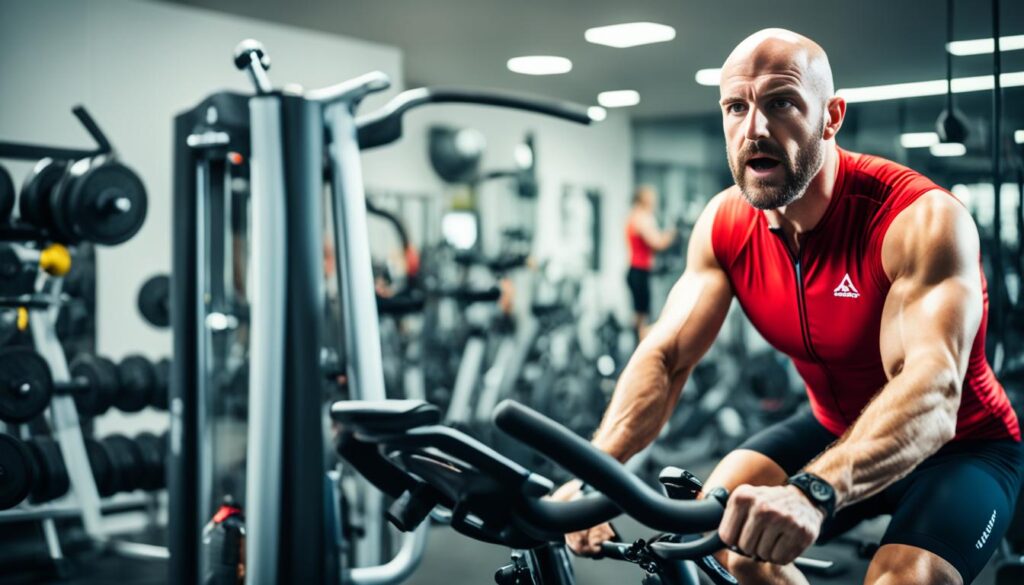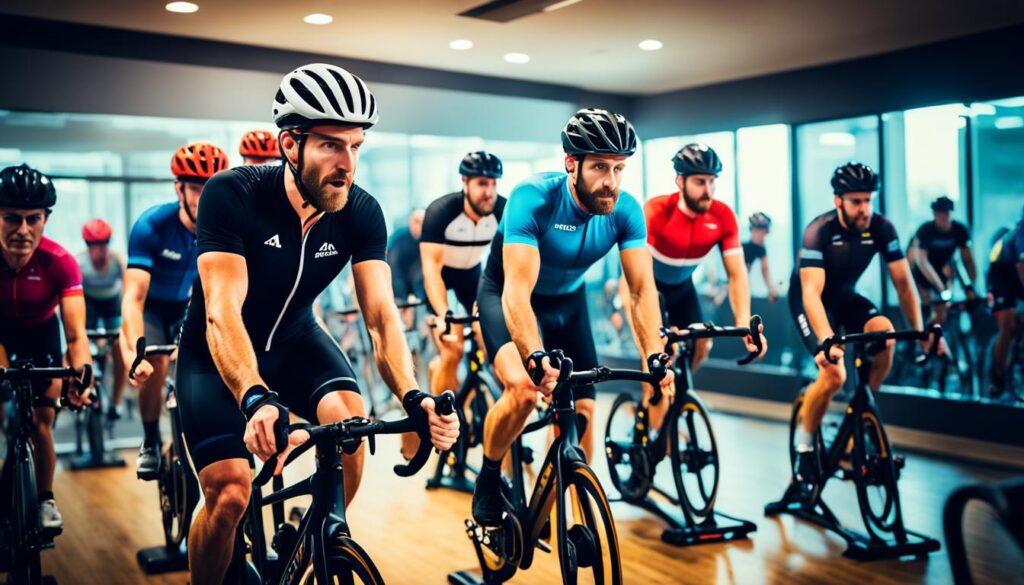Are you ready to take your cycling performance to the next level? Whether you’re a seasoned cyclist or just starting, the key to reaching your full potential lies in the right combination of workouts, nutrition, and training plans. But what exactly does it take to optimize your cycling fitness and training?
In this article, we will dive into the science-backed strategies and expert tips that can help you maximize your cycling performance and endurance. From power-pumping workouts to bespoke nutrition plans, we will explore the essential elements that can make a significant difference in your cycling journey. So get ready to pedal your way to greatness!
But first, let’s take a moment to reflect on the importance of workouts, nutrition, and training plans in your quest for cycling excellence. Consider this:
Key Takeaways
- Workouts, nutrition, and training plans play a crucial role in improving cycling performance and endurance.
- Power-pumping workouts are essential for enhancing cycling fitness by targeting strength and endurance.
- Bespoke nutrition plans tailored to individual needs and goals can optimize cycling performance.
- Robust training plans, including interval training and long rides, are key to building cycling endurance.
- Strength training exercises focusing on key cycling muscles can improve cycling power and performance.
Power-Pumping Workouts for Cycling Fitness

In the world of cycling, fitness, and performance go hand in hand. To reach new heights on two wheels, it’s essential to incorporate power-pumping workouts into your training regimen. These high-intensity exercises are designed to enhance strength, endurance, and overall performance on the bike.
Cycling workouts are not just about pedaling for miles on end. They involve targeted exercises that challenge your muscles and cardiovascular system in different ways. By diversifying your training routine, you can push past plateaus and accelerate your progress.
So, what exactly are these power-pumping workouts? Let’s dive in and explore:
Interval Training:
A popular and effective technique, interval training involves alternating between periods of high-intensity cycling and recovery. It helps improve cardiovascular fitness, increase muscular endurance, and enhance your ability to sustain intense efforts during a race or long ride. Incorporating intervals into your training routine can simulate the demands of real-world cycling scenarios, making you a stronger and more resilient rider.
Hill Repeats:
Cycling up hills can be a challenging but rewarding endeavor. Hill repeats involve cycling up a steep incline multiple times, with short recovery periods in between. This workout builds leg strength, improves climbing ability, and enhances overall power output. By conquering hills in training, you’ll have the confidence and strength to tackle any elevation on your cycling adventures.
Sprint Training:
Sprinting in cycling requires explosive power and quick bursts of energy. Incorporating sprint training into your workouts can improve your acceleration, top speed, and ability to respond to surges in a group ride or race. These high-intensity efforts simulate the demands of sprinting for the finish line, helping you gain a competitive edge.
But remember, no workout is complete without proper technique and form. Ensure you have the right bike setup, maintain good posture, and engage the correct muscles during each exercise. Additionally, prioritize recovery and rest days to allow your body to repair and grow stronger.
Now that you have an understanding of power-pumping workouts for cycling fitness, why not mix things up and challenge yourself with these effective training techniques? Let’s take your cycling performance to the next level!
Bespoke Nutrition for Cycling Performance
When it comes to cycling performance, nutrition is the secret sauce that fuels success. Just like a finely tailored suit, bespoke nutrition plans provide cyclists with the personalized fuel they need to optimize their performance on the bike.
But what exactly is bespoke nutrition? It’s about crafting a nutrition plan that is tailored to your specific needs and goals as a cyclist. No generic diets or cookie-cutter meal plans here – we’re talking about nutrition that is designed specifically for you.
So, how can you harness the power of bespoke nutrition to enhance your cycling performance? Here are a few tips and recommendations to get you started:
- Fuel up with the right macronutrients: Carbohydrates, protein, and healthy fats are the building blocks of a cyclist’s diet. Focus on consuming a balance of these macronutrients to provide your body with the energy and nutrients it needs to perform at its best.
- Timing is key: Proper timing of your meals and snacks can make a big difference in your performance. Aim to fuel up before and after your rides to optimize energy levels and recovery.
- Stay hydrated: Hydration is crucial for maintaining peak performance on the bike. Make sure to drink plenty of water before, during, and after your rides. Electrolyte-rich drinks can also help replenish important minerals lost through sweat.
“Bespoke nutrition is like a finely tuned engine – it provides the optimal fuel to keep you performing at your best.” – Pro Cyclist, Emma Richards
Remember, every cyclist is unique, and what works for one person may not work for another. That’s why it’s important to work with a qualified nutritionist or dietitian who can help you create a bespoke nutrition plan that takes into account your individual needs, goals, and dietary preferences.
Fueling the Body for Cycling Performance: A Sample Meal Plan
To give you an idea of what a bespoke nutrition plan for cycling performance might look like, here’s a sample meal plan to get you started:
| Meal | Menu |
|---|---|
| Breakfast | Oatmeal with berries and almond butter |
| Mid-Morning Snack | Greek yogurt with granola and sliced banana |
| Lunch | Grilled chicken salad with mixed greens, quinoa, and avocado |
| Afternoon Snack | Trail mix with nuts, seeds, and dried fruit |
| Dinner | Salmon with roasted vegetables and quinoa |
| Evening Snack | Apple slices with almond butter |
Keep in mind that this is just a sample meal plan, and it’s important to personalize it based on your individual needs and preferences. Working with a nutritionist can help you tailor this plan to meet your specific goals, whether it’s increasing energy, improving recovery, or optimizing weight management.
Remember, nutrition is the key to unlocking your cycling potential. By fueling your body with bespoke nutrition, you’ll have the energy, endurance, and power to take your cycling performance to new heights. So, get ready to conquer the road and fuel your success with personalized nutrition.
Robust Training Plans for Cycling Endurance

When it comes to improving your cycling endurance, a well-designed training plan is crucial. Endurance training is the key to building stamina and pushing past your limits on the bike. By incorporating different types of training into your program, such as interval training, long rides, and hill repeats, you can enhance your endurance and ride longer, stronger, and faster.
“Endurance is not just the ability to bear a hard thing, but to turn it into glory.” – William Barclay
Interval training, with its alternating periods of high-intensity effort and recovery, is an effective way to boost your cardiovascular fitness and improve your body’s ability to process and utilize oxygen during exercise. Long rides, on the other hand, help build your aerobic capacity and teach your body to sustain effort over extended periods. And let’s not forget about hill repeats, which not only challenge your leg strength but also improve your mental toughness.
The Different Types of Training Plans
Depending on your goals, fitness level, and available time, there are various training plans you can choose from. Here’s a breakdown of the most common types:
| Training Plan | Description |
|---|---|
| Base Training | A period of low-intensity, high-volume training aimed at building a solid foundation of endurance. |
| Interval Training | Alternating periods of high-intensity effort and recovery to improve cardiovascular fitness and increase power. |
| Long Rides | Extended rides at a steady pace to build aerobic capacity and mental resilience. |
| Hill Repeats | Repeated climbs up hills or gradients to enhance leg strength and tolerance to intensity. |
Remember, it’s important to listen to your body and gradually increase the intensity and duration of your training sessions. A well-structured and progressive training plan, tailored to your specific needs and abilities, will help you reach new levels of endurance and achieve your cycling goals.
Next in the article, we’ll delve into the importance of strength training for cycling performance and how it can complement your endurance training program.
Strength Training for Cycling Performance

When it comes to improving your cycling performance, strength training should not be overlooked.
While cycling primarily relies on endurance and cardiovascular fitness, incorporating strength exercises into your training routine can provide significant benefits. By targeting key muscle groups used in cycling, such as the legs, core, and upper body, you can enhance your power, stability, and overall performance on the bike.
So, what are some specific strength exercises that can take your cycling to the next level? Let’s take a look:
1. Squats
One of the best exercises for building lower-body strength, squats engage your quads, hamstrings, and glutes. By performing squats regularly, you’ll develop greater pedal power and stability during your rides.
2. Planks
A strong core is essential for maintaining proper posture and stability while cycling. Planks are a great exercise for strengthening your core muscles, including your abs and lower back.
3. Deadlifts
Deadlifts are a compound exercise that targets multiple muscle groups, including the glutes, hamstrings, and lower back. They help improve your overall strength and power, making them a valuable addition to your cycling training program.
4. Push-ups
While cycling primarily focuses on the lower body, having upper body strength can improve your overall performance and efficiency on the bike. Incorporate push-ups into your strength training routine to develop your chest, shoulders, and triceps.
5. Lunges
Lunges are excellent for targeting your quads, hamstrings, and glutes, while also improving your stability and balance. Incorporating lunges into your workouts can help enhance your cycling power and prevent muscular imbalances.
Remember, strength training for cycling should be supplementary to your regular rides. Aim for 2-3 strength training sessions per week, focusing on proper form and gradually increasing the intensity over time.
By incorporating these exercises into your training routine, you can take your cycling performance to new heights. Strength training is not just for bodybuilders—it’s a valuable tool for cyclists looking to improve power, endurance, and overall performance on the bike.
Get ready to unleash your cycling potential with a well-rounded fitness regimen that includes strength training!
The Role of Mental Focus in Cycling Fitness and Training

When it comes to cycling fitness and training, it’s not just about physical prowess. Mental focus plays a vital role in achieving peak performance on the bike. Whether you’re tackling grueling climbs or sprinting towards the finish line, maintaining a strong mental game can make all the difference in your cycling journey.
Research has shown that a focused mindset can enhance endurance, improve decision-making, and increase overall performance in cycling. By harnessing the power of mental focus, you can push your limits, overcome obstacles, and break through plateaus.
So how can you optimize your mental focus during cycling workouts and competitions? Here are some techniques and strategies to help you train your mind for success:
- Visualization: Picture yourself achieving your cycling goals, visualizing the route, and envisioning success. This mental imagery can improve your confidence and help you stay motivated during challenging rides.
- Goal Setting: Set clear and realistic goals for each training session or race. Breaking down your objectives into smaller milestones can make them more attainable and provide a sense of accomplishment along the way.
- Positive Self-Talk: Replace negative thoughts with positive affirmations. Remind yourself of your capabilities and focus on your strengths. Encourage yourself during tough moments to keep pushing forward.
- Mindfulness: Practice being present in the moment during your rides. Pay attention to your breath, your body sensations, and the environment around you. This mindfulness can help you stay focused and in control, especially during high-intensity efforts.
- Routine and Rituals: Establish pre-ride routines or rituals that prepare you mentally for the challenges ahead. This could include a specific warm-up routine, a motivational playlist, or a mantra that you repeat to yourself before setting off.
Remember, mental focus is a skill that can be trained and developed, just like your physical fitness. Incorporate these strategies into your cycling training regimen, and you’ll see improvements not only in your performance but also in your overall enjoyment of the sport.
“Train your mind as hard as you train your body, and watch your cycling potential soar.”
So, next time you hop on your bike, don’t forget to engage your mental muscles. Stay focused, stay motivated, and ride towards your goals with unwavering determination.
Benefits of Mental Focus in Cycling |
Techniques to Enhance Mental Focus |
|---|---|
|
|
Indoor Cycling Classes for Fitness and Training

Looking for a structured and convenient way to boost your cycling fitness and training? Look no further than indoor cycling classes. These classes offer a dynamic and engaging workout experience that can take your cycling to the next level.
Participating in indoor cycling classes brings a multitude of benefits to your training regimen. Firstly, it provides a consistent and regular training schedule. With scheduled class times, you’ll be more likely to stick to your training routine, ensuring you consistently work towards your cycling goals.
The variety of workouts available in indoor cycling classes is another major advantage. Qualified instructors curate the classes to include a mix of interval training, endurance rides, and even simulated hill climbs, ensuring a well-rounded and comprehensive workout. This variety challenges different energy systems, builds strength, and improves overall fitness, resulting in enhanced cycling performance.
Furthermore, indoor cycling classes offer a motivating and energetic atmosphere. Exercising alongside a group of like-minded individuals can boost your motivation and provide the extra push needed to surpass your limits. The collective energy and camaraderie in a class setting can make a significant difference in your training experience.
How can you incorporate indoor cycling classes into your training schedule? The key is to find a balance that complements your existing cycling routine. Consider adding one or two indoor cycling classes per week to supplement your outdoor rides. This allows you to focus on specific training objectives while enjoying the benefits of both indoor and outdoor cycling.
Keep in mind that consistency is key. To optimize your results, aim for regular attendance in indoor cycling classes. Find a schedule that aligns with your availability and commit to attending classes consistently. Incorporate indoor classes strategically as part of your broader training plan, ensuring they support and enhance your cycling goals.
The Best Indoor Cycling Classes
| Class Name | Location | Instructor |
|---|---|---|
| SweatCycle | City Cycle Studio | Samantha Smith |
| Ride Revolution | Revolution Fitness | James Johnson |
| CycleStrong | Power Pedal Studio | Emily Davis |
Discovering the best indoor cycling classes in your area is crucial to ensure you receive top-notch instruction and a fulfilling workout experience. Here are a few popular classes to consider:
- SweatCycle: Located at City Cycle Studio, this class led by instructor Samantha Smith focuses on high-intensity interval training and sprint intervals. Get ready to sweat while pushing your limits.
- Ride Revolution: Revolution Fitness offers this class led by instructor James Johnson. Ride Revolution combines endurance training, hill climbs, and motivating music to push your cycling performance to new heights.
- CycleStrong: Led by instructor Emily Davis at Power Pedal Studio, CycleStrong focuses on strength and power development through a mix of high-intensity intervals and resistance-based workouts.
Remember to check the schedule and availability of these classes as they may vary. Choose a class that suits your preferences, and availability, and aligns with your specific training goals. Whether you’re a novice cyclist or a seasoned rider, indoor cycling classes offer a supportive and engaging environment to enhance your fitness and training.
The Impact of Neurodiversity on Cycling

Neurodiversity is a concept that recognizes and celebrates the natural variations in neurocognitive functioning among individuals. In the context of cycling, neurodiversity encompasses a range of conditions such as Autism Spectrum Disorder (ASD) and Attention Deficit Hyperactivity Disorder (ADHD).
Factual data indicates that a significant number of cyclists may identify as neurodivergent, meaning their neurological characteristics deviate from the norm. While neurodivergent individuals may face unique challenges, they also possess distinct strengths and perspectives that can greatly influence their cycling performance.
Experiences of Neurodivergent Cyclists
Neurodivergent cyclists may have heightened sensory sensitivities, allowing them to be more attuned to the environment while riding. They may notice subtle changes in terrain, wind patterns, or the positioning of other riders, enabling them to make quick and strategic decisions on the road.
Additionally, neurodivergent individuals often possess intense focus and passion for their interests. This level of dedication can translate into an unwavering commitment to cycling training, resulting in exceptional discipline and dedication to improve performance.
“Cycling offers me a sense of freedom and liberation. As an autistic cyclist, the rhythmic motion and the connection with nature provide a calming and grounding experience that helps me manage sensory sensitivities and find peace within myself.” – Alex Thompson, Neurodivergent Cyclist
Influencing Performance on the Bike
The unique characteristics of neurodivergent cyclists can have a profound impact on their performance. Their ability to focus deeply on specific tasks, combined with heightened sensory awareness, can result in a heightened level of concentration and precision while cycling.
Moreover, neurodivergent individuals often possess a natural inclination for pattern recognition and problem-solving. This cognitive advantage can aid in navigating complex routes, adjusting to changing conditions, and optimizing bike handling skills.
It is important to recognize and celebrate the diversity of experiences and talents within the cycling community. By embracing neurodiversity, we can foster a more inclusive and supportive environment that empowers all cyclists to reach their full potential.
Overcoming Stigma and Seeking Support in Cycling

The stigma around neurodiversity in the world of cycling can create significant barriers for individuals who identify as neurodivergent. Whether it’s the stigma associated with conditions like autism spectrum disorder (ASD) or attention deficit hyperactivity disorder (ADHD), many neurodivergent cyclists face unique challenges when seeking support and resources to enhance their cycling experience.
The cycling community must recognize the importance of raising awareness and cultivating a more inclusive and supportive environment for neurodivergent cyclists. By dismantling the existing stigma, we can create a space where everyone, regardless of their neurological differences, feels welcome and supported.
Seeking Support within the Cycling Community
One of the first steps in overcoming stigma is to seek support within the cycling community. There are various avenues available for neurodivergent cyclists to connect with like-minded individuals, share experiences, and find resources tailored to their specific needs.
- Online Communities: Joining online platforms and forums dedicated to neurodivergent cyclists can provide a sense of belonging and access to a wealth of knowledge and support.
- Cycling Groups: Investigate local cycling groups that prioritize inclusivity and diversity. These groups often offer specialized programs and resources for neurodivergent cyclists.
- Support Organizations: Reach out to organizations that focus on providing support and advocacy for neurodivergent individuals in the cycling community. They can offer guidance, mentorship, and connectedness.
It’s crucial to remember that seeking support is a sign of strength, not weakness. By connecting with others who understand and empathize with the challenges of neurodiversity, cyclists can gain valuable insights, encouragement, and assistance in navigating the cycling world.
“When cyclists embrace and support each other’s differences, we create an environment where everyone can thrive and reach their fullest potential.”
Breaking down the barriers associated with the stigma around neurodiversity is a collective effort. It requires education, empathy, and open-mindedness within the cycling community. We must strive to foster an environment where neurodivergent cyclists feel empowered to pursue their passion for cycling and can access the support they need to overcome any challenges they may face.
Accessing Cycling Fitness and Training Resources
Enhancing cycling fitness and performance requires access to reliable and effective resources and training programs. Fortunately, there are numerous platforms and online resources available to cyclists, offering a wealth of valuable information and guidance.
- Cycling Fitness Websites: Several websites cater specifically to cyclists, providing comprehensive information on workouts, nutrition, training plans, and more. These websites feature expert advice, articles, and training programs designed to optimize cycling performance. Examples include CyclingTips, Bicycling.com, and Cycling Weekly.
- Online Training Programs: Many organizations and fitness experts offer online training programs tailored to cyclists of all levels. These programs typically include structured workouts, training plans, and performance-tracking tools. Platforms like TrainerRoad, TrainingPeaks, and Zwift offer interactive training programs that simulate various cycling terrains and challenges.
- Cycling Coaches: For personalized guidance and tailored training plans, consider working with a professional cycling coach. Coaches provide expertise, accountability, and individualized advice to help cyclists reach their specific fitness and performance goals. Seek recommendations from trusted sources or consult directories such as the American Cycling Association.
Unlock Your Cycling Potential with These Resources
“With the right resources and training programs at your disposal, you can unlock your full cycling potential. Whether you’re a beginner or an experienced rider, these platforms and tools will help you take your fitness and performance to new heights.”
| Cycling Fitness Resources | Highlights |
|---|---|
| CyclingTips | A comprehensive website offering expert advice on training, nutrition, and more. |
| Bicycling.com | An online hub for cycling enthusiasts with workout plans, gear reviews, and training tips. |
| Cycling Weekly | A trusted source for cycling news, training guides, and performance-focused articles. |
| TrainerRoad | An interactive training platform with structured workouts and performance analytics. |
| TrainingPeaks | A platform offering personalized training plans, performance metrics, and goal tracking. |
| Zwift | An online training program that combines immersive virtual rides with social features. |
| American Cycling Association | A directory of certified cycling coaches who can provide personalized training guidance. |
By accessing these resources and utilizing training programs tailored to your needs, you can optimize your cycling fitness and training, leading to improved performance on the bike.
Conclusion
Cycling fitness and training are the keys to unlocking your best performance and endurance on the bike. Through this article, we have explored the importance of incorporating workouts, nutrition, and training plans into your cycling routine.
By following expert tips and guidance, you can optimize your fitness and training strategies to achieve your cycling goals. The data supports the fact that targeted workouts enhance strength, endurance, and overall performance on the bike.
Remember, proper nutrition tailored to your individual needs is crucial for maximizing cycling performance. Additionally, robust training plans, including interval training and long rides, are essential for building endurance and stamina.
Whether you’re a beginner or an experienced cyclist, implementing strength training exercises and fostering a strong mental focus will help you take your performance to the next level. For those seeking convenience, indoor cycling classes offer a structured and motivating environment to improve your fitness and training.
In conclusion, cycling fitness and training are the foundation for achieving your cycling goals. With the insights and guidance provided in this article, you are equipped to optimize your performance on the bike and enhance your endurance for every ride.
